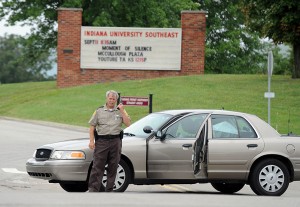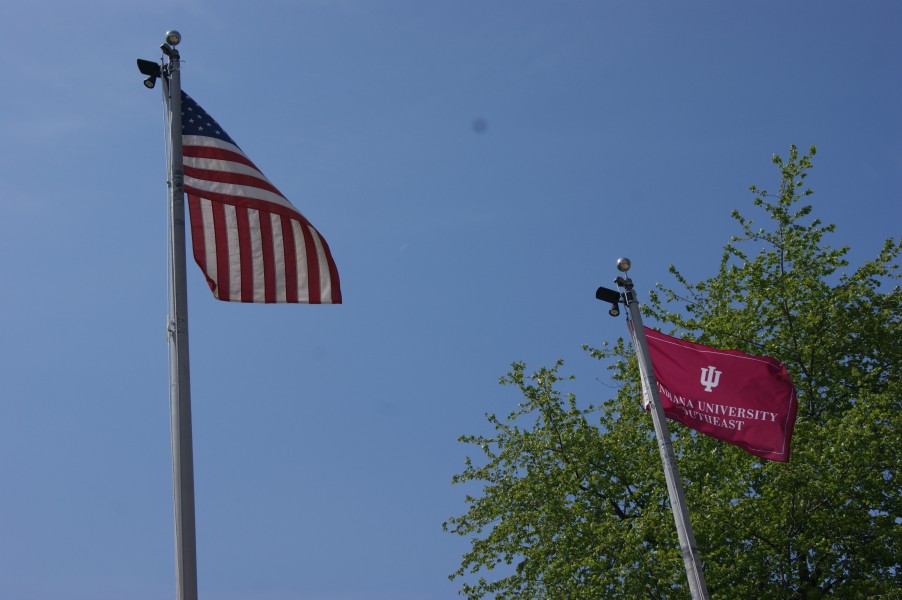IU Southeast campus on edge:
Students and faculty share their stories of the latest lockdown
Photo by Tyler Stewart/News and Tribune (used with permission)
Greg Ezell, Jeffersonville, walks his daughter, Kymber, to their vehicle in the Indiana University Southeast parking lot following a lock-down stemming from reports of an armed gunman on campus. The false alarm was triggered after a student reported seeing what looked to be a gun handle sticking out of a camouflage backpack. Emergency responders arrived on campus around 1 p.m. where they identified the object as a large umbrella and the issue was then resolved.
September 20, 2014
David Baird was on his way to teach his Introduction to Economics course and could tell something was odd. It was just a few minutes after 1 p.m. on a Thursday and the cafeteria in University Center was locked up and empty.
“I cut through the dining hall, and there was nobody in there,” said Baird, lecturer in economics.Knobview Hall was the same, and as he walked into room 107 and found all his students staring at their phones he had one question: “What is going on?”
“There is a shooter on campus,” a student told him.
This was the situation classrooms across IU Southeast found themselves in on Sept. 11, 2014.
The second campuswide lockdown in 10 months sent students and faculty into hiding. Local SWAT and police units swarmed campus as IU Notify alerted users to be on the lookout for a man wearing light color shorts and a camouflage backpack. The lockdown lasted 50 minutes before an “all-clear” was sent.
Before that all-clear was sent, however, the fear of an active shooter on campus was very real.
“We never had anything happen like that in my high school,”said Evan Longmaker, business freshman, and a student in Baird’s class. “I know this stuff is real because of Virginia Tech and Columbine.”
Baird, who was also teaching a class during the December 2013 lockdown, said he immediately began to assess the situation. The room they were in had two doors on either side. Neither door locked, and they opened outward, so barricading them was not an option.
“The room is full of people — it’s at capacity,” Baird said. “So it’s not like you can hide them.”
Across campus, Joe Hollingsworth wasn’t worried about hiding students; he was trying to get them to dissappear all together.
Hollingsworth, professor of computer science, said when he found out about the lockdown he directed a group of students in the parking lot to leave campus. He then headed into the Life Sciences Building and said he could hear a professor, who was not aware of what was going on, still teaching.
“I remembered that those doors [to that classroom] lock, so I got my key and interrupted class,” Hollingsworth said. “I locked them in, and I came back to my office and sat there with the lights off, being quiet and worked.”
Back in Knobview Hall, Charles Pooser was in his office when he saw the IU Notify alert pop up in his email. He took in two students into his office and locked the door.
Pooser, associate professor of French, said the students were a little concerned but calm. They mostly studied and contacted relatives to let them know they were ok.
Not far away, Baird said he focused on the hallway outside his room for the first 15 minutes of class.
Longmaker said having an open door made him uncomfortable.
“[Baird]was standing outside in the hallway, no one else out there,” Longmaker said. “But if he drops, we are all sitting here with an open door.”
After a few minutes, Baird said, students began getting text messages from friends on campus reporting that officers were searching for the suspect in Crestview Hall. He said he asked the students if they wanted to continue having class.
“We just decided to keep on having class,” Baird said. “Nothing is happening; it is pretty calm; we were getting reports that they were searching in Crestview for the student.”
Longmaker said that for the most part, students were calm, although they were not tuned into Baird’s lecture.
“No one was paying attention,” Longmaker said. “We were all looking through our phones and texting friends getting updates.”
Baird said that cooler heads prevail in a crisis and that freaking out would do no good.
“They are going to feed off you as a leader,” Baird said, “I am taking it serious, I am continuing to watch the door and monitor noise in the hallway. But because the doors open out, because you can’t lock them, because there is a window for each door, I wasn’t going to just sit by and wait inside that room.”
At one point, a student not in the class walked through the room’s unlocked doors. He could not join his own class because the doors had been barricaded.
“He was obviously not a threat, but there was no stopping him from coming in,” Baird said. “It is a little disconcerting, because you don’t know.”
Baird said locks are the most important thing that the campus needs to make IU Southeast safer. He also suggested holding drills, having some type of alarm and getting peep holes for doors without windows.
“When you are in a room and you cannot see anything, you are at a real disadvantage,” Baird said. “Anybody can say, ‘I am the police.’”
Hollingsworth said he felt safe but didn’t dare stick his head out of his office door to see what was going on. He said that although locks would help in the event of a gunman on campus, it is not that simple.
“Students can be in the stairways, students can be in the bathroom, students can be in the coffee shop,” Hollingsworth said. “It is going to be very difficult to come up with a correct policy for all those situations and have everyone know what those procedures are.”
Pooser said that the next day, a member of the custodial staff was checking doors to see which ones locked.
“That’s a major concern and something I think we need to look at,” he said. “If you can’t lock your doors, it’s a problem to have to move a desk in front of the door.”
Baird, Hollingsworth and Pooser all said they have received some sort of training on how to handle emergency situations. IU Southeast is also planning on requiring further training in the future.
Baird said that he knows that the administration is working with experts to make campus safer but that public safety experts may lack a faculty perspective. “I am not always so sure they see it from inside the classroom,” Baird said.





